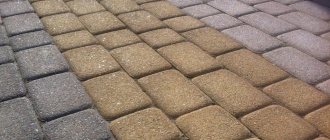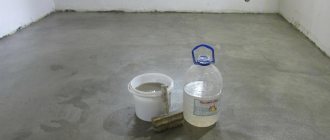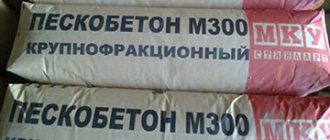On large construction sites, the material is received in the form of a finished product from factories for its production. When building individual houses of small volumes, it is more profitable to prepare the concrete mixture to be laid on the construction site.
Work with concrete consists of the following actions:
- Preparation of the mixture.
- Installation of formwork, its dismantling after completion of work.
- Laying of reinforcement.
- Laying concrete and compacting the mixture.
- Concrete surface care.
Polypropylene fiber
Universal polypropylene reinforcing fiber for adding to the solution.
More details
Important!
When rearranging the vibrator, maintain a distance of no more than 1.5 radii of action. When processing a new layer, the deep vibrator is immersed 5–8 cm into the previous layer to ensure the solidity of the product.
Tamping with manual and pneumatic rammers is used when laying super-rigid concrete mixtures in lightly reinforced and unreinforced structures or when it is impossible to use vibration.
Casting
Laying concrete mixture by casting is used when using mobile mixtures P4–P5. As a rule, these are mixtures with plasticizers.
In this case, the mixture does not require processing; it spreads and compacts under the influence of gravity.
This method of laying and compacting the concrete mixture allows you to save cement, electricity, labor costs and obtain durable structures. It is also suitable for use in thin-walled or densely reinforced structures.
Pressure concrete placement
Pressure concreting is used, for example, in cases where it is necessary to lay the concrete mixture under water.
In this case, a fill of coarse aggregate is created in the formwork, then concrete solution is supplied under pressure through steel pipes installed at a certain distance from each other. When the thickness of the structure is less than 1 m, the solution is injected through the side injection holes.
The advantages of this method include:
- reducing labor costs for mixing concrete mixture;
- elimination of concreting seams, since the process is carried out continuously;
- simplified work technology.
One of the disadvantages is the need to use solutions with a high cement content.
Important!
The methods of casting and pressure laying are called special methods and are used in cases where laying and compaction by conventional methods (vibration, compaction) is impractical, ineffective or impossible.
Seal
Preparation, transportation and placement are carried out when the concrete is in a loose state, the aggregate particles are loosely located and the free space between them is filled with air. Thanks to a process called compaction, it is possible to ensure the homogeneity of concrete and its high density.
The main and most common method of compaction when performing monolithic masonry is vibration, the principle of which is based on the use of a number of properties of the concrete mixture. The concrete mixture is a plastic-viscous body, which occupies an intermediate position between true liquids and solids. It has structural strength and is able to resist shearing.
The action of vibration is aimed at reducing the adhesion force between the grains. In this case, the mixture loses structural strength and acquires properties that are inherent in a heavy viscous liquid. The liquefaction process is classified as reversible, and upon completion of exposure, the strength of the structure is restored.
The action of vibration leads to the fact that the aggregate particles produce oscillatory movements, the concrete mixture liquefies, acquires mobility and increased fluidity. As a result, it is better distributed in the formwork, filling it.
Types of vibrators for concrete compaction.
The vibration process is carried out using deep, external and surface vibrators. The working part of the internal vibrators, immersed in the concrete mixture, transmits vibrations through the housing. Surface vibrators are installed on the concrete mixture to be compacted and transmit vibrations through the working platform. External vibrators are secured to the formwork using a vice or other gripping devices; in this case, vibrations are transmitted through the formwork.
The use of a particular type of vibrator is determined by the size and shape of the structure being concreted, the required intensity of concreting and the degree of reinforcement. Internal vibrators are used in work related to massive structures of varying degrees of reinforcement. Internal ones equipped with a flexible shaft are used in densely reinforced structures. Surface vibrators are only capable of compacting the top layers of concrete, so they have found their application in concreting floors and thin slabs.
Each type of vibrator has its own effective compaction zone, which is characterized by a radius of action for external and internal vibrators.
Rules for laying concrete mixture
Technological techniques used for concreting depend on the type of structure, design features of the formwork, climatic conditions, and composition of the concrete mixture:
- Concrete is placed into massive structures by unloading directly into the formwork, feeding it with a concrete pump or in buckets using cranes. Mixtures with a cone draft of 1–3 cm are used for lightly reinforced structures and mixtures with a cone draft of 4–6 cm are used for densely reinforced structures. The thickness of the laid layers of concrete mixture should be 30–40 cm.
- Small structures (such as partitions, beams, columns) are concreted immediately to their entire height without interruption in order to eliminate the construction of working joints. In large structures, the mixture is laid in horizontal layers, usually over the entire area at once. Each of these layers is compacted.
- Regardless of the chosen concreting method, a new portion of concrete is placed before the previous one begins to set, so that there is no need to create seams in the structure. On large structures, if this condition cannot be met, the mixture is poured in “steps” at least 3 m long.
- The floors are concreted and compacted with a vibratory screed, then treated with trowels. For the underlying layers, mixtures with a cone settlement of 0 to 2 cm are used. The underlying layers are concreted with “cards”-strips 3–4 m wide one at a time.
- The mixture is placed in the slabs in one layer.
- When constructing walls, the thickness of each section should not exceed 3 m. For walls more than 50 cm thick, subject to sparse reinforcement, mixtures with a cone draft of 4–6 cm are used. For thin and densely reinforced walls and partitions, mixtures with a cone draft of 6–10 cm are used.
Working seams
When laying concrete in layers, they strive to prevent the previous layer from setting in order to ensure the solidity of the structure. However, if you need to take a break from work, a working seam is arranged.
It is obtained if more than 7 hours have passed since the previous layer of concrete was laid, and it is able to withstand a dynamic impact of at least 1.5 MPa without destruction.
In this place the structure is weakened, so the working seam can only be made in the places specified by the technical documentation.
The plane of the working seam is arranged perpendicular to the axis of the element, and for walls and slabs - perpendicular to their surface.
To ensure that the layers are securely bonded to each other, the previous layer is processed:
- use wire brushes to clean the edge until the coarse aggregate is exposed;
- clean reinforcement bars;
- blown and washed with water;
- Before concreting, the cleaned surface is covered with a cement mortar with a composition corresponding to the composition of the concrete mixture used.
Preparatory work
Blind area sections ready for pouring
Before starting work on pouring concrete, prepare the construction site: remove debris, mark the future structure, and begin installing formwork. The materials used for this are wooden blocks, boards, moisture-resistant plywood, metal or plastic. The formwork can be removable, which is dismantled after the concrete hardens; it is used for repeated work. The elements of the non-removable system remain in the body of the finished structure.
The dimensions inside the formwork have design values with small tolerances (2 mm per meter of structure length). The internal walls must be smooth and clean, carefully fitted, and sealed. To easily remove the formwork after use, they are lined with polyethylene and lubricated with a soap-oil solution. To ensure rigidity, the fence is tightened with bolts or studs in increments of 100–200 cm, and spacers are installed on the outside.
The formwork is dismantled after 8–10 days, when the strength of the material reaches 80% of the brand value. For load-bearing walls and foundations, it is removed after reaching 100% strength. This also applies to long structures over 8 meters.
An important part of concrete work is reinforcement with metal frames and meshes. The rods are welded at right angles of a certain diameter. The laying step is chosen from 100 to 400 mm. The values of the pitch and diameter of the rod are determined by calculation depending on the load, grade of cement and size of the element.
The frames are connected by several meshes into a three-dimensional structure using connecting rods. The connection is carried out by welding, clamps, and binding wire. The protective layer of concrete above the reinforcement is 20–30 cm below and above the element. To reinforce 1 m3 of concrete structure, 70–120 kg of reinforcement is required.
Features of winter concreting
The optimal conditions for gaining concrete strength are air temperature +18–22° C and air humidity close to 100%.
However, in many regions of Russia, the air temperature remains below 0°C for about six months. It is unprofitable to stop construction work for such a period; besides, winter concreting has its advantages:
- in winter, building materials may cost less;
- on soft soils it is better to concrete in winter;
- In winter, it is easier to get to the construction site.
Important!
According to SP 70.13330, winter concreting is the laying of concrete at average daily temperatures below 5°C or at minimum daily temperatures below 0°C. In this case, the concrete will not harden without special measures.
Polypropylene fiber
Universal polypropylene reinforcing fiber for adding to the solution.
More details
In order to obtain high-quality concrete in winter, it is necessary to prevent freezing of the concrete mixture during transportation and immediately after laying until critical strength is achieved. The critical strength is determined by technical documentation, is usually 30–50% of the design strength and is achieved, as a rule, on the 4–6th day after installation.
To do this, use various methods or combinations thereof:
- thermos method;
- construction of greenhouses;
- heating the concrete.
The thermos method is used for massive structures. Because the hydration reactions that occur in concrete produce heat, the massive structure heats itself. It is enough to cover it with heat-insulating materials, and unless there is too much frost, the process of strengthening in it will not stop.
Teplyakami are special tents that are erected over the structure. Heat guns are installed inside to ensure a minimum sufficient temperature above 5°C. This method is expensive, requires equipment and consumes electricity.
To heat the laid concrete, electrodes, IR radiation and other methods are used. This is also an expensive and equipment-requiring method.
All of these methods are called "warm concrete", but "cold concrete" can also be laid. For this purpose, anti-frost additives HotIce and CemFrio are used, which allow successful concreting even at very low temperatures.
When using "warm" concreting, additives are also used to accelerate the achievement of the critical strength of concrete. In this case, additives that accelerate hardening are used, for example, HotIce, CemFrio and CemFix.
We advise you to study: For carrying out work in cold weather
Preparing for pouring
Before attaching the foundation formwork for pouring concrete, it is necessary to perform a number of preliminary measures: prepare tools, mortar, and a platform. Concrete for pouring is selected in accordance with the required characteristics and time of year, soil characteristics (freezing depth, heaving, groundwater level). In order to increase strength, they are reinforced with metal reinforcement, the quantity, diameter and pitch of which are selected in accordance with the characteristics of the soil and climate.
Concreting can be done with a solution prepared independently from cement, sand, crushed stone and water, or from a ready-made dry mixture. You cannot skimp on the quality of materials; you need to prepare it in a concrete mixer. The following tools and devices are used for work: a shovel, a hammer, measuring instruments, a concrete mixer and containers for measuring mixtures, a sledgehammer, a vibrating machine or a bayonet for tapping the formwork.
First, the formwork is assembled, installed, secured, and position adjusted. The geometry of the enclosing structures must be ideal, the walls must be vertical, and there must be no gaps in the joints through which concrete can leak out when pouring. The diagonals between opposite corners should not differ by more than 30 millimeters maximum.
After installation, the concrete formwork is thoroughly cleaned inside so that there is no dirt and debris, then the reinforcement is laid. The frame must be equipped with clamps that do not allow the mesh rods to touch the surfaces on the sides and bottom. Fix the cord on top (checking the evenness with a building level) and fill it along it. Next, the formwork is filled with mortar around the perimeter, allowed to gain strength, and the panels are dismantled.
How to Make a Perfect Concrete Mix
Modern concreting is difficult to imagine without the use of special additives for concrete mixtures, which are designed to impart certain properties to concrete and make it higher quality and easier to use.
The advantage of Cemmix additives is that they are developed and tested in laboratories and give completely predictable results:
- to increase the strength, workability of the mixture, as well as to save cement, plasticizers and superplasticizers CemBase, CemStone, CemPlast, Plastix are used;
- to obtain durable concrete at low temperatures, antifreeze additives HotIce and CemFrio, as well as the concrete hardening accelerator CemFix are required;
- to increase the impact strength of concrete, strengthen it, and replace reinforcement, polypropylene or basalt fiber is used;
- To obtain durable and waterproof concrete, it is recommended to use the CemAqua additive, and it is also recommended to treat concrete surfaces in contact with water with the complex water-repellent CemAquaStop.
Cemmix additives are very economical and easy to use, and some of them can save significant amounts of cement.
Concreting methods depend on the type of structure and the conditions in which construction work is carried out. But with any method, stronger and higher quality concrete can be obtained using modern high-tech Cemmix additives.
You can buy CemPlast, CemBase CEMMIX without leaving your home, with discounts from 5 to 33%!!!!
Buy on Ozon
Buy on Yandex.Market
Buy on Wildberries
Buy at Leroy Merlin
Or you can find the nearest official dealer in your region on our map
← Why is it necessary to seal the joints of sandwich panels, and what materials are used to make it
Installation of shrinkage joints in concrete floors →
Return to list
Comments
Types of formwork
Concrete can be poured directly into the ground, without formwork - simply dig a trench in the ground and pour cement into it. This option is suitable for constructing a strip-type foundation with the ability to withstand not very heavy loads.
But the most popular formwork option for pouring concrete is the production of a collapsible structure from wooden panels, which are assembled with fasteners, then the timber is installed. The planed side of the formwork board is turned inward so that the monolith is smooth. After dismantling the formwork, the boards can be used again in pouring concrete or for other needs.
Construction plywood with laminated side surfaces is also used. It is also assembled with shields, secured on the outside with bent metal rods. The equipment is made of metal, mounted and dismantled using a truck crane.
Metal formworks are produced by enlarging panels into mounting panels using a lifting mechanism. The parts are assembled and fixed with bolts and welds. To prevent concrete from sticking when pouring, the inside of the structure is lubricated with a special emulsion.
Often, mobile formwork is used to pour concrete, which is suitable for the construction of multi-level walls of a structure. During the process of concrete hardening, the metal panels are dismantled and moved further higher in level. Typically, such options are chosen for residential and industrial construction.
Formworks manufactured in industrial conditions require strengthening of the working planes and are equipped with improved fastening systems to speed up installation and dismantling. In this way, it is possible to increase the speed of construction several times, which is important for frame-based structures.
Sometimes the use of permanent polystyrene foam formwork is required. The design is a box without a bottom and a lid, in which internal partitions are installed to ensure the required level of rigidity when pouring.
News
We are always ready to help
Cemmix has opened a free hotline
to help you with any questions related to construction using concrete additives. Call and ask, our consultants are always ready to help!
Hyperplasticizer
Hyperplasticizers are a new type of plasticizing additives for concrete, ensuring the mobility of the mixture above P5. In addition to plasticity, they increase the water resistance and frost resistance of concrete by 2-3 times.











